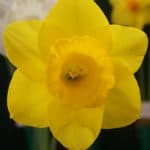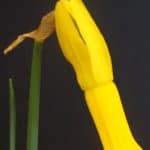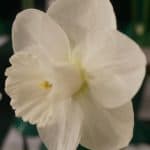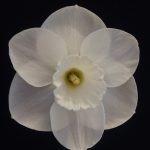
The garden at Rosemoor is in a wonderful setting and the Narcissus cyclamineus and Narcissus bulbocodium which are naturalised in the grass were at their best as the photo above shows. Unfortunately high winds damaged the intended location of the show a couple of days before resulting in its relocation into the lecture room and educational centre. Georgina and the Rosemoor staff are to be congratulated for the way in which they coped so well with the situation.


 Adrian Scamp put on a fine ‘trade stand’ and Christine Skelmersdale and Jackie Petherbridge made good use of the limited space available to mount a small educational display. The serious lack of space prevented Carlos van der Veek from displaying the wonderful pots of daffodils and hyacinths that he had brought from Holland until much later in the day (hence no photograph), however his generosity in allowing them to be raffled off resulted in a good donation to the Marie Curie Charity.
Adrian Scamp put on a fine ‘trade stand’ and Christine Skelmersdale and Jackie Petherbridge made good use of the limited space available to mount a small educational display. The serious lack of space prevented Carlos van der Veek from displaying the wonderful pots of daffodils and hyacinths that he had brought from Holland until much later in the day (hence no photograph), however his generosity in allowing them to be raffled off resulted in a good donation to the Marie Curie Charity. Within the same hall was the camellia show for the flower which grows so well in that part of the world. In addition there were a number of classes for alpines and bulbs in pots which also added to overall splendour of the show.
Within the same hall was the camellia show for the flower which grows so well in that part of the world. In addition there were a number of classes for alpines and bulbs in pots which also added to overall splendour of the show.
In the classes for for standard daffodils, Ivor Clark had a field day winning virtually all the classes. Three of his best vases are shown below. Ombersley; Arleston (3 blooms); Impeccable, Banker, Heamoor, Honeybourne, Silent Valley.



Two of the classes that Ivor did not win were those for blooms from division 10 and division 5. These were won by the youngest exhibitor Edwin Lanyon from Truro (shown here with mentor Christine Skelmersdale) with Oxford Gold and Angel’s Whisper.

There are only two Best Bloom awards at this show, the chosen flowers being Best Standard Daffodil, Seedling F41 shown by Carlos van der Veek for which there are two photographs below and Best Miniature Narcissus cyclamineus shown by Brian Duncan.
For many years after daffodil exhibiting began in the 1800s there was little interest in miniature daffodils in the United Kingdom. Alec Gray in the middle of the 20th century changed that with the introduction of the flowers that are those which are the ones mainly shown in competition today. John Blanchard then took over the reins as the main hybridiser but there was so little interest in small flowers that several of his raisings crossed the Atlantic to the USA to find a home. Ron Scamp, Anne Wright, John Gibson and Brian Duncan, among the Commercial Growers and an increasing number of amateur exhibitors have now taken up the cudgels to support what is now a very popular section. It is interesting to see at this show and also at the Early Competition at Wisley that members of the general public show much greater interest in miniature flowers than in the standard daffodils. Unfortunately because many of the species narcissus, and hybrids from them, flower much earlier than standard daffodils it is only at those two shows that the full range of what is now available or about to be released can be seen and enjoyed. At Daffodil Society shows exhibited miniatures must come from a list whose concept was agreed at a time of low miniature popularity and where seedling flowers and those not in commerce are not allowed in most classes.
 Brian Duncan has long complained that he got very little competition in the miniature classes at the RHS shows. Here he got his wish fulfilled with four entries in the collection class for nine flowers. In first place (the RH entry) was Brian Duncan with John Gibson (next to Brian’s entry) in second place, and Anne Wright (LH entry) in third. The unplaced entry consisting of nine species narcissus (a feat to achieve in itself) was James Akers whose hybridisation of miniatures has only recently begun. What is also remarkable about the entries in this class is that of the 36 flowers in the class, 32 of them were different, N. cyclamineus with three flowers and N. cantabricus and Cheekie Chappie the only repeated blooms.
Brian Duncan has long complained that he got very little competition in the miniature classes at the RHS shows. Here he got his wish fulfilled with four entries in the collection class for nine flowers. In first place (the RH entry) was Brian Duncan with John Gibson (next to Brian’s entry) in second place, and Anne Wright (LH entry) in third. The unplaced entry consisting of nine species narcissus (a feat to achieve in itself) was James Akers whose hybridisation of miniatures has only recently begun. What is also remarkable about the entries in this class is that of the 36 flowers in the class, 32 of them were different, N. cyclamineus with three flowers and N. cantabricus and Cheekie Chappie the only repeated blooms.
A number of flowers were suggested as possible candidates for the Ralph B White Trophy including two of Brian’s ‘coloured’ miniature seedlings 3814 Maria X N. triandrus concolor and 3243 Candlepower X My Word.






A wonderful report James. It was good to be back at Rosemoor after our two year gap judging the Wessex show. When the new facilities for this show are completed in 2018 it will be even more special. Don’t forget the locally grown vegetables in the restaurant, as well as the superb gardens.
James did not say that he was highly commended for his remarkable exhibit of nine different species and natural hybrids.
We thought the expanses of species daffs in the Rosemoor gardens were as good, or better than, those at Wisley, and well worth the trip to see.
A super report James. Thanks for posting.
The miniature entries at Rosemoor are the best in the country and I think they melt the hearts of even the most hardened standards grower!
For clarity , The Daffodil Society reviews the Miniature list every year and expands it to include new blooms that are consistent, commercially available and flower during the show season. A set list gives clarity for novice growers and ensures that weak and badly grown small flowers from Intermediate or even standard cultivars are not shown.
Sadly, as you point out, the peak flowering time for many of the newer miniatures is in March which is long before our show dates. Three cheers for Alec Gray!
Well done everyone who did so well at Rosemoor.
Just to mention the wonderful exhibit put on at RHS Cardiff yesterday by the Scamp Family. Was this their best exhibit yet i wonder?.